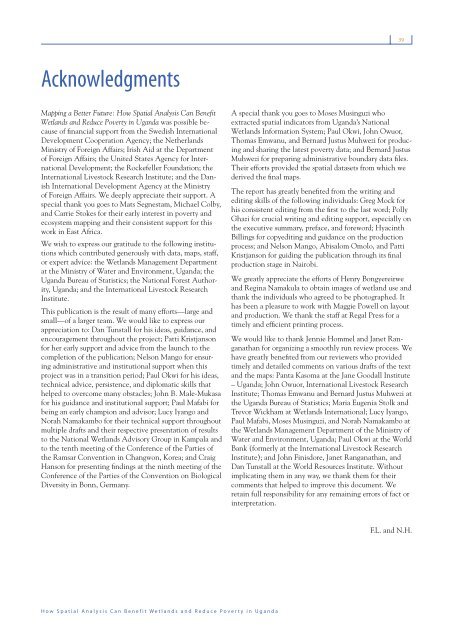Mapping a Better Future - World Resources Institute
Mapping a Better Future - World Resources Institute
Mapping a Better Future - World Resources Institute
You also want an ePaper? Increase the reach of your titles
YUMPU automatically turns print PDFs into web optimized ePapers that Google loves.
39<br />
Acknowledgments<br />
<strong>Mapping</strong> a <strong>Better</strong> <strong>Future</strong>: How Spatial Analysis Can Benefi t<br />
Wetlands and Reduce Poverty in Uganda was possible because<br />
of fi nancial support from the Swedish International<br />
Development Cooperation Agency; the Netherlands<br />
Ministry of Foreign Affairs; Irish Aid at the Department<br />
of Foreign Affairs; the United States Agency for International<br />
Development; the Rockefeller Foundation; the<br />
International Livestock Research <strong>Institute</strong>; and the Danish<br />
International Development Agency at the Ministry<br />
of Foreign Affairs. We deeply appreciate their support. A<br />
special thank you goes to Mats Segnestam, Michael Colby,<br />
and Carrie Stokes for their early interest in poverty and<br />
ecosystem mapping and their consistent support for this<br />
work in East Africa.<br />
We wish to express our gratitude to the following institutions<br />
which contributed generously with data, maps, staff,<br />
or expert advice: the Wetlands Management Department<br />
at the Ministry of Water and Environment, Uganda; the<br />
Uganda Bureau of Statistics; the National Forest Authority,<br />
Uganda; and the International Livestock Research<br />
<strong>Institute</strong>.<br />
This publication is the result of many efforts—large and<br />
small—of a larger team. We would like to express our<br />
appreciation to: Dan Tunstall for his ideas, guidance, and<br />
encouragement throughout the project; Patti Kristjanson<br />
for her early support and advice from the launch to the<br />
completion of the publication; Nelson Mango for ensuring<br />
administrative and institutional support when this<br />
project was in a transition period; Paul Okwi for his ideas,<br />
technical advice, persistence, and diplomatic skills that<br />
helped to overcome many obstacles; John B. Male-Mukasa<br />
for his guidance and institutional support; Paul Mafabi for<br />
being an early champion and advisor; Lucy Iyango and<br />
Norah Namakambo for their technical support throughout<br />
multiple drafts and their respective presentation of results<br />
to the National Wetlands Advisory Group in Kampala and<br />
to the tenth meeting of the Conference of the Parties of<br />
the Ramsar Convention in Changwon, Korea; and Craig<br />
Hanson for presenting fi ndings at the ninth meeting of the<br />
Conference of the Parties of the Convention on Biological<br />
Diversity in Bonn, Germany.<br />
A special thank you goes to Moses Musinguzi who<br />
extracted spatial indicators from Uganda’s National<br />
Wetlands Information System; Paul Okwi, John Owuor,<br />
Thomas Emwanu, and Bernard Justus Muhwezi for producing<br />
and sharing the latest poverty data; and Bernard Justus<br />
Muhwezi for preparing administrative boundary data fi les.<br />
Their efforts provided the spatial datasets from which we<br />
derived the fi nal maps.<br />
The report has greatly benefi ted from the writing and<br />
editing skills of the following individuals: Greg Mock for<br />
his consistent editing from the fi rst to the last word; Polly<br />
Ghazi for crucial writing and editing support, especially on<br />
the executive summary, preface, and foreword; Hyacinth<br />
Billings for copyediting and guidance on the production<br />
process; and Nelson Mango, Abisalom Omolo, and Patti<br />
Kristjanson for guiding the publication through its fi nal<br />
production stage in Nairobi.<br />
We greatly appreciate the efforts of Henry Bongyereirwe<br />
and Regina Namakula to obtain images of wetland use and<br />
thank the individuals who agreed to be photographed. It<br />
has been a pleasure to work with Maggie Powell on layout<br />
and production. We thank the staff at Regal Press for a<br />
timely and effi cient printing process.<br />
We would like to thank Jennie Hommel and Janet Ranganathan<br />
for organizing a smoothly run review process. We<br />
have greatly benefi ted from our reviewers who provided<br />
timely and detailed comments on various drafts of the text<br />
and the maps: Panta Kasoma at the Jane Goodall <strong>Institute</strong><br />
– Uganda; John Owuor, International Livestock Research<br />
<strong>Institute</strong>; Thomas Emwanu and Bernard Justus Muhwezi at<br />
the Uganda Bureau of Statistics; Maria Eugenia Stolk and<br />
Trevor Wickham at Wetlands International; Lucy Iyango,<br />
Paul Mafabi, Moses Musinguzi, and Norah Namakambo at<br />
the Wetlands Management Department of the Ministry of<br />
Water and Environment, Uganda; Paul Okwi at the <strong>World</strong><br />
Bank (formerly at the International Livestock Research<br />
<strong>Institute</strong>); and John Finisdore, Janet Ranganathan, and<br />
Dan Tunstall at the <strong>World</strong> <strong>Resources</strong> <strong>Institute</strong>. Without<br />
implicating them in any way, we thank them for their<br />
comments that helped to improve this document. We<br />
retain full responsibility for any remaining errors of fact or<br />
interpretation.<br />
F.L. and N.H.<br />
How Spatial Analysis Can Benefit Wetlands and Reduce Poverty in Uganda

















